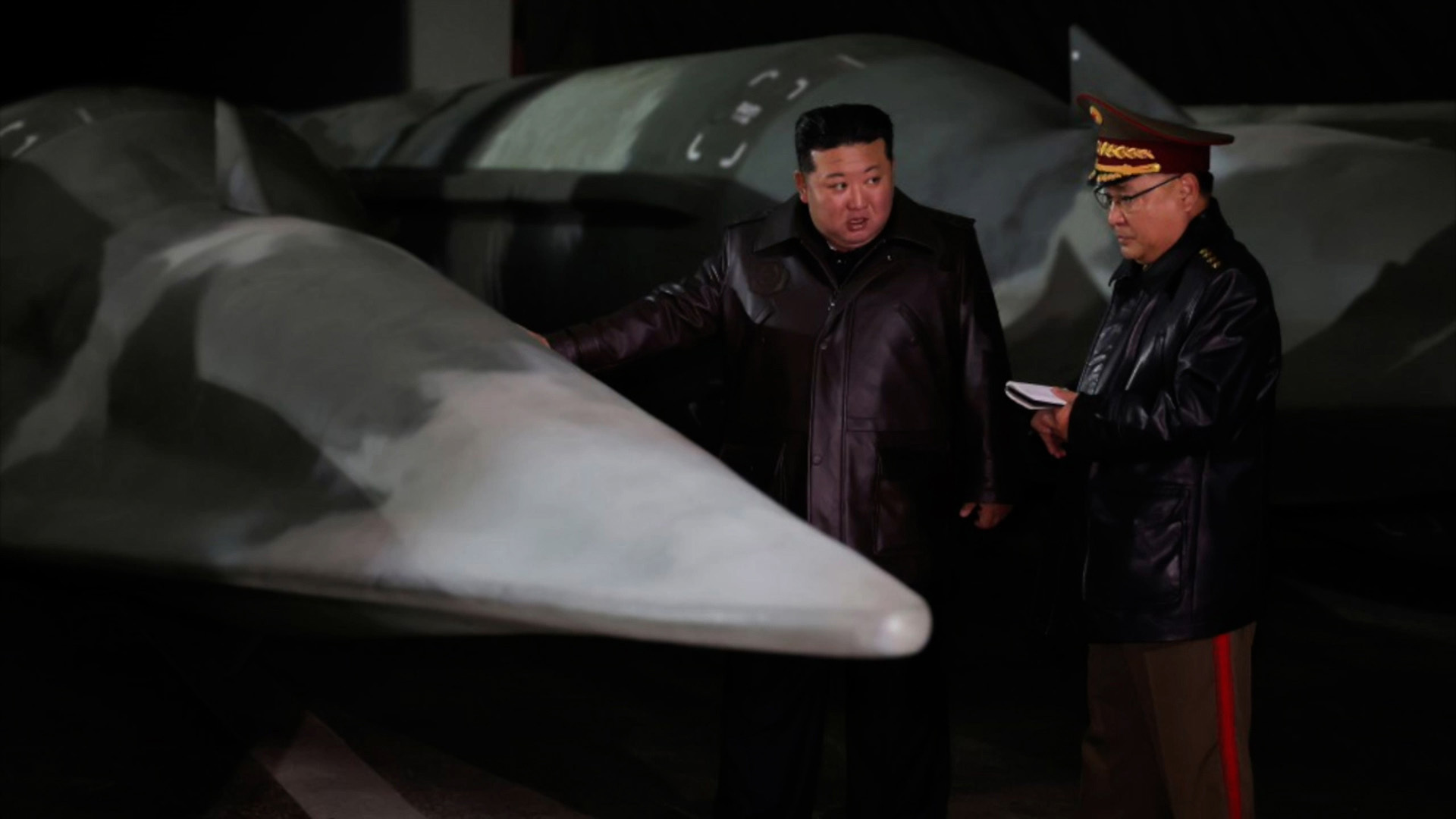
North Korea fires ICBM; US, South Korea respond with simulated strikes
By Ryan Robertson (Anchor), William Jackson (Producer), Zachary Hill (Video Editor)
North Korea conducted a significant intercontinental ballistic missile test early Thursday, Oct. 31, with U.S. and South Korea responding swiftly through coordinated air drills, simulating strikes on North Korean missile targets. This marks North Korea’s first long-range missile test in almost a year, a launch that South Korea’s Joint Chiefs of Staff suggest may be a display of strength ahead of the U.S. presidential election.
Media Landscape
See how news outlets across the political spectrum are covering this story. Learn moreBias Distribution
Left
Right
Untracked Bias
The missile, launched from near Pyongyang, reached a record altitude of 4,300 miles and stayed airborne for over 80 minutes — one of the longest North Korean missile flights to date.
Fired at a steep angle to avoid neighboring airspace, the missile’s trajectory aligns with North Korea’s recent strategy to showcase range capability without provoking further regional backlash.

Download the SAN app today to stay up-to-date with Unbiased. Straight Facts™.
Point phone camera here
North Korean leader Kim Jong Un oversaw the launch, describing it as “appropriate military action” in response to perceived threats, signaling his continued commitment to expanding North Korea’s nuclear capabilities.
This latest test, in clear defiance of U.N. Security Council resolutions prohibiting North Korea from conducting such long-range nuclear-capable missile tests, underscores the country’s growing missile advancements.
Japan confirmed the missile’s landing approximately 190 miles from Okushiri Island near Russia’s coast, with Japanese Defense Minister Gen Nakatani calling the launch a direct threat to both Japan and international stability.
Get up to speed on the stories leading the day every weekday morning. Sign up for the newsletter today!
Learn more about our emails. Unsubscribe anytime.
By entering your email, you agree to the Terms & Conditions and acknowledge the Privacy Policy.
In response to the North’s ICBM launch, U.S., South Korean and Japanese forces conducted joint air exercises involving over 100 aircraft, aimed at reinforcing their defense posture and deterring further North Korean provocations.
The drills simulated strikes on mock North Korean missile sites, underscoring the allies’ preparedness and commitment to regional security.
Experts say North Korea’s high-angle missile tests could potentially reach up to 9,300 miles on a standard, flatter trajectory, which would place the U.S. mainland within range. However, uncertainties remain regarding North Korea’s ability to accurately deliver a nuclear warhead over such distances.
KIM YONG-HYUN
SOUTH KOREAN DEFENSE MINISTER
“The nuclear and missile threat from North Korea is now an existential threat not only to the ROK but also to the Indo-Pacific region.”
[Ryan Robertson]
NORTH KOREA JUST LAUNCHED A POWERFUL INTERCONTINENTAL BALLISTIC MISSILE, ITS FIRST LONG-RANGE TEST IN ALMOST A YEAR. IT TOOK OFF FROM NEAR PYONGYANG EARLY THURSDAY AND STAYED IN THE AIR FOR OVER 80 MINUTES—LONGER THAN ANY RECENT NORTH KOREAN TEST.
NOW, HERE’S WHAT’S REALLY INTERESTING: NORTH KOREA HAS BEEN FIRING THESE MISSILES AT A SUPER-STEEP ANGLE, BRINGING THEM DOWN SOONER THAN THEIR FULL RANGE WOULD ALLOW. EXPERTS SAY IT’S PARTLY A SAFETY MOVE AND ALSO A WAY TO AVOID THE BACKLASH THAT MIGHT COME FROM SENDING A MISSILE FAR INTO THE PACIFIC.
SOUTH KOREA’S JOINT CHIEFS OF STAFF REPORTED THIS TEST COULD BE SEEN AS A SHOWCASE OF NORTH KOREA’S LONG-RANGE CAPABILITIES. AS FOR THE TIMING, THE JOINT CHIEF SAYS IT’S LIKELY MEANT TO COINCIDE WITH THE UPCOMING U.S. PRESIDENTIAL ELECTION.
THE MISSILE REACHED A RECORD ALTITUDE OF 4,350 MILES, SURPASSING PREVIOUS TESTS — AND SIGNALING CONTINUED ADVANCEMENTS IN NORTH KOREAN MISSILE TECHNOLOGY.
NORTH KOREAN LEADER KIM JONG UN OVERSAW THE TEST, CALLING IT AN “APPROPRIATE MILITARY ACTION” IN RESPONSE TO WHAT HE SEES AS THREATS TO HIS COUNTRY
US OFFICIALS DENOUNCED THE LAUNCH AS A “FLAGRANT VIOLATION” OF U.N. RESOLUTIONS. ADDING THE TEST DIRECTLY VIOLATES U.N. SECURITY COUNCIL RESOLUTIONS BANNING NORTH KOREA FROM TESTING NUCLEAR-CAPABLE MISSILES.
IN RESPONSE, THE U.S. and SOUTH KOREA HELD JOINT AIR DRILLS, INVOLVING OVER 100 AIRCRAFT, SIMULATING STRIKES ON NORTH KOREAN MISSILE SITES TO REINFORCE THEIR COMBINED DEFENSE CAPABILITIES.
SOUTH KOREA PREVIOUSLY ALERTED OF POTENTIAL NORTH KOREAN MISSILE TESTS, WITH EXPERTS NOTING THESE HIGH-ANGLE LAUNCHES AVOID NEARBY AIRSPACE WHILE STILL DEMONSTRATING NORTH KOREA’S POTENTIAL RANGE.
ANALYSTS SUGGEST NORTH KOREA’S MISSILES COULD POTENTIALLY REACH UP TO 9,300 MILES ON A STANDARD TRAJECTORY, WHICH WOULD PUT THE U.S. MAINLAND WITHIN RANGE. HOWEVER, IT’S UNCERTAIN WHETHER THESE MISSILES COULD CARRY A NUCLEAR WARHEAD ACCURATELY OVER THAT DISTANCE.
FOR MORE OF OUR UNBIASED, STRAIGHT FACT REPORTING ON NORTH KOREA AND THE TENSIONS IN THE REGION–BE SURE TO DOWNLOAD THE STRAIGHT ARROW NEWS APP TODAY, OR LOG ON TO SAN.COM
FOR STRAIGHT ARROW NEWS, I’M RYAN ROBERTSON
Media Landscape
See how news outlets across the political spectrum are covering this story. Learn moreBias Distribution
Left
Right
Untracked Bias
Straight to your inbox.
By entering your email, you agree to the Terms & Conditions and acknowledge the Privacy Policy.
MOST POPULAR
-
 Reuters
Reuters
Diddy’s defense attorney abruptly requests withdrawal from case
Watch 1:4015 hrs ago -
 Getty Images
Getty Images
Judge allows CNN lawsuit potentially worth billions to continue
Read19 hrs ago -
 Reuters
Reuters
It’s a bird, it’s a plane, it’s the first video of Alef Aeronautics’ flying car
Watch 2:1320 hrs ago -
 Getty Images
Getty Images
Democrats in Congress receive lowest approval rating in Quinnipiac poll history
Watch 2:5921 hrs ago




